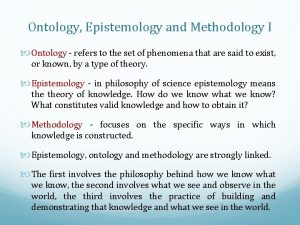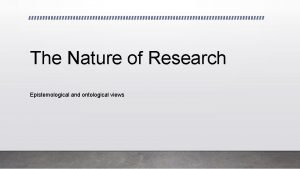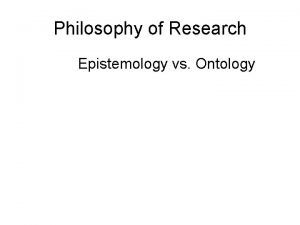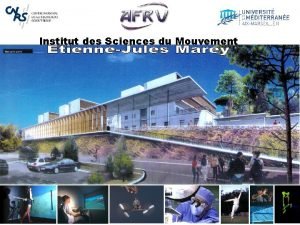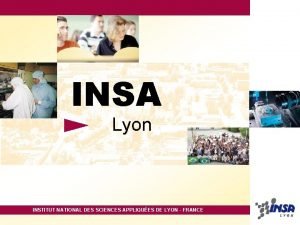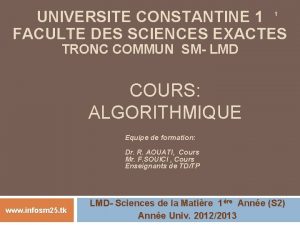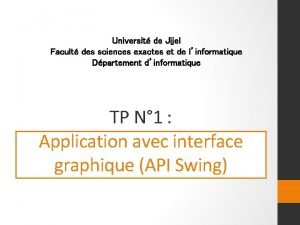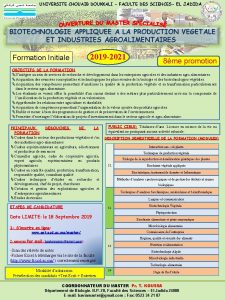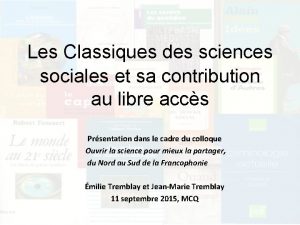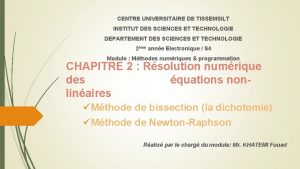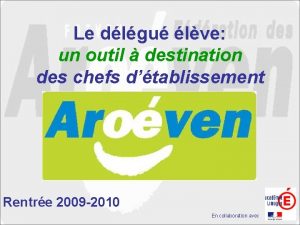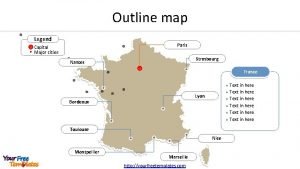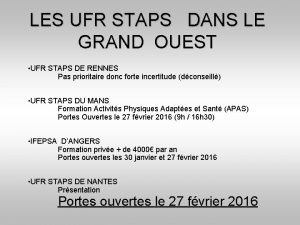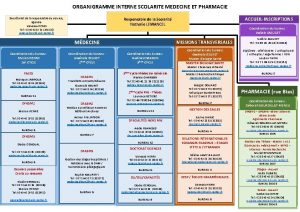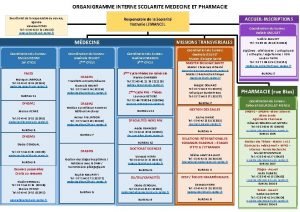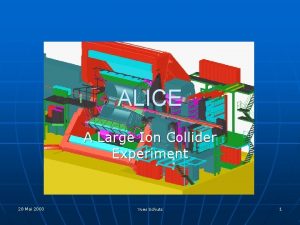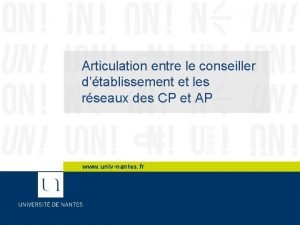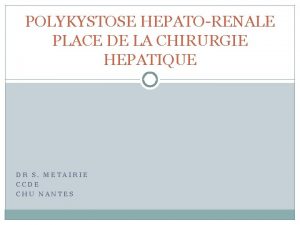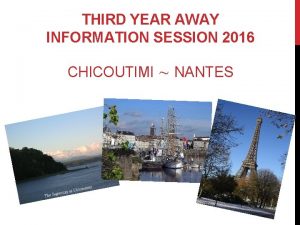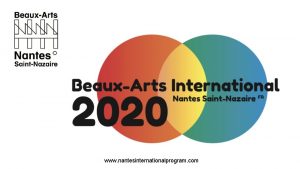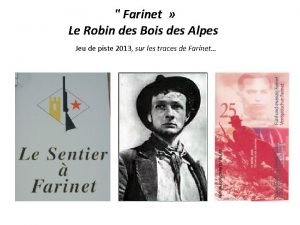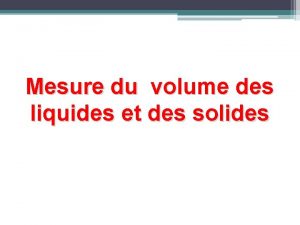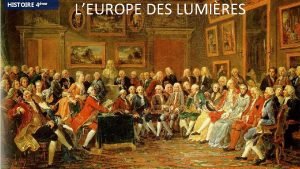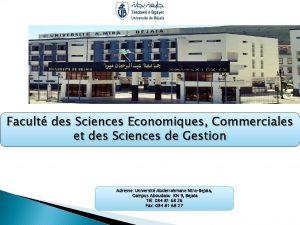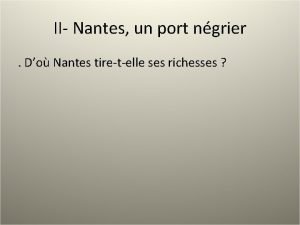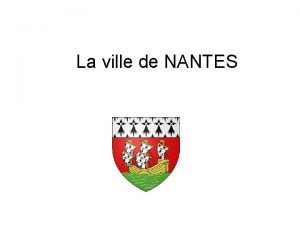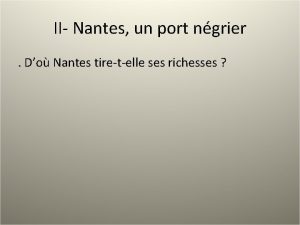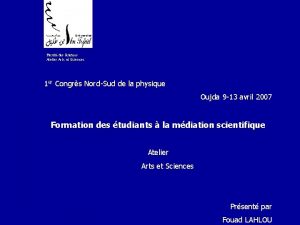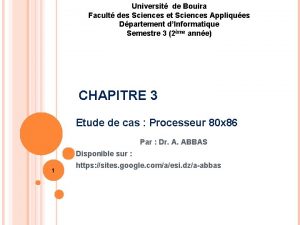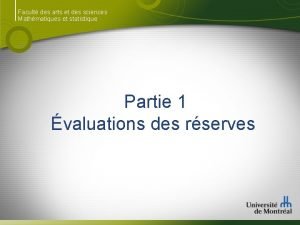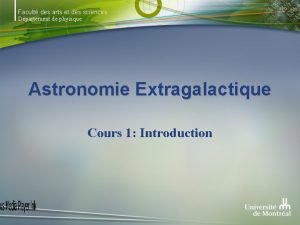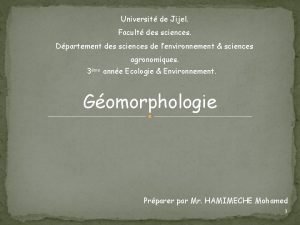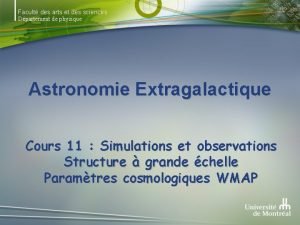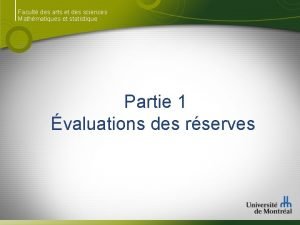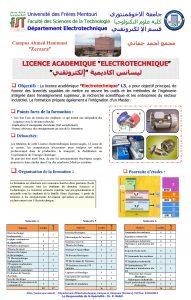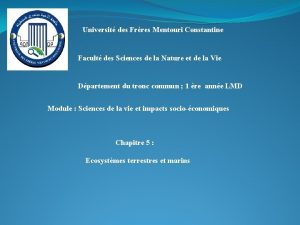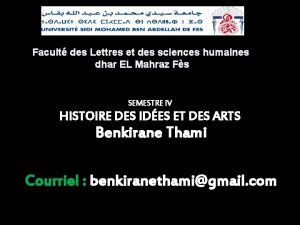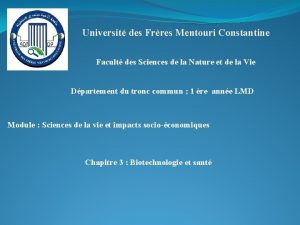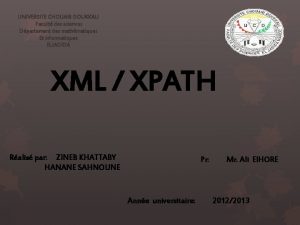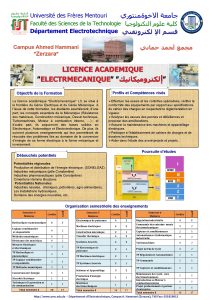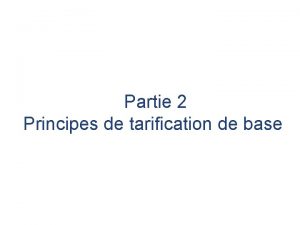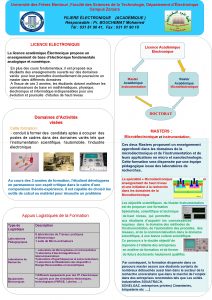SPS 2018 Facult des sciences de Nantes Epistemological
































- Slides: 32

#SPS 2018 Faculté des sciences de Nantes Epistemological reflexions on collecting in medicine: What can we learn from the practices of a 19 th century Parisian anatomy society? z Juliette Ferry-Danini – Ph. D student in philosophy, Research fellow, Sorbonne Université ferry. danini@gmail. com @ferrydanini 4 -6 juillet

z A misleading title for my talk? My focus will be the practices of the members of the Parisian Anatomy Society (in the XIXe century) yet I will also talk a lot about another collecting institution: the Dupuytren Museum. Why?

z Outline: 1) The context of my research 2) Why study the Dupuytren Collection? 3) How? With what goals? 4) Collecting practices in the Dupuytren Collection and the Parisian Society of Anatomy (XIXe) 5) Perspectives

z 1) The context of my research: § The Dupuytren pathology collection (XIXe/XXe) closed to the public in 2016. § It is now located in the basements of Sorbonne Université (former-UPMC/Université Paris-Sorbonne). § Several medical collections in Europe face such a similar fate. § Medical collections as minor and/or inconvenient parts of history of medicine and history of science ? v Project “Paré” funded by Sorbonne Universités.

z The Dupuytren Collection

z The Dupuytren Collection

z The Dupuytren Collection

z The Dupuytren Collection

z The Dupuytren Collection The building

z A famous specimen Monsieur Leborgne’s brain Collected by Broca Discovery of the brain’s speech areas (“Broca’s area)

z i. 2) Why study Dupuytren Collection? History of collection and collecting is rarely done Rudwick 2001, review of Simon J. Knell, The culture of English geology, 1815– 1851 (Aldershot, 2000), in The Times Literary Supplement, 4 May 2001, 27. Robert E. Kohler, 2007, “Finders, keepers: collecting sciences and collecting practice, ” Hist. Sci. , xlv. 2006, All Creatures. Naturalists, Collectors, and Biodiversity, 1850 -1950, Princeton University Press. « museological sciences » (Pickstone 1994) « inventory sciences » (Zeller 1987)

z 3) How to do it? Which type of history to study an object such as the Dupuytren collection? - Historical study of scientific figures and institutions (prosopography) - Study of scientific ideas and knowledge - Study of scientific practices - Study of particular objects ii. History of practices of collecting are even more rarely done Tybjerg, K. (2015). From Bottled Babies to Biobanks Medical Collections in the Twenty-First Century. In Fate of Anatomical Collections (Rina Knoeff; Robert Zwijnenberg. , pp. 263– 278). Farnham: Ashgate

z The goal? Going against the commonplace narrative of progress in medicine The usual narrative: medicine (and biology) progressed by giving up collecting for laboratory practices? “Beyond these relatively clear-cut cases… (…). Pathological anatomy (…) began as an objectbased science, before leaving museums for the epistemically more secure and respectable venue of pathology labs. ” (Kohler 2007, 431) Drawing inspirations from Strasser 2012 a, 2012 b and Tybjerg 2015. Strasser argued that comparisons can be drawn between natural history and data-driven practices in molecular biology (2012 a, b). Tybjerg argued that similar comparisons can be drawn between medical museums and modern biobanks (2015).

z Integrating history and philosophy of medicine My approach is twofold: 1) it is first a historical study of scientific collecting practices it; taking the Dupuytren Collection as a case study. 2) Asking epistemological questions about the nature and the aims of collecting in medicine (in XIXe) 3) [Arguing that collecting well understood is still important and practiced in contemporary medicine (too ambitious for today)]

z How to study the practices associated with the Dupuytren Collection ? § La Société Anatomique de Paris Or the “Parisian Anatomy Society” (SAP) (picture: Guillaume Dupuytren 1877 -1935) Florent Palluault (1999): Etudiants et praticiens au service de la médecine : la société anatomique de Paris de 1803 à 1873 Étude institutionnelle et prosopographique d’une société médicale parisienne au XIXe siècle (thèse d’histoire de la médecine, 1999).

z i. Historical background at the turn of the XIXe century: Institutionnal hodgepodge during the French Revolution Le Chapelier and Allarde laws (1791) ii. Scientific context Linné, Boissier de Sauvages Morgagni, Bichat Landmarks of the Société Anatomique de Paris and Duputyren collection: 1803: birth of the SAP (disappears in 1809) 1826: rebirth of the SAP 1835: creation of Dupuytren Museum (picture: Jean Cruveilhier 1871 -1974 )

z 4) Collecting in the Parisian Anatomy Society: why and how ?

z 1. Collecting as in finding, gathering and showing: a) The admission procedure Admission steps to become an associated member of the society: § Bringing and showing a pathological specimen § Explaining § § the history of the disease § the clinical state of the patient § the autopsy report § one’s conclusions regarding the pathology § the general relevance of the piece of medical knowledge Delivering a detailed written description of the piece

z b) The daily functioning of the Society revolves around the collective examination of specimens Discours de Jean-Baptiste Barth en 1846 lors de la séance publique annuelle (ci-contre) : “If there is one undisputable and universally held truth today, it is that facts are important for the progress of sciences, and that their results are superior to any kind of smart speculative ideas. (…) In our Society, every discovery of normal anatomy is immediately supported by the substantiating piece of evidence and it becomes a discovery only when the demonstration is deemed obvious by our members”.

z c) Strategies for gathering bodies: « Le citoyen SAVARY rappelant à la Société que dans ce moment les dissections sont presqu’entièrement suspendues et que c’est des observations faites dans les hôpitaux que la Société doit surtout s’enrichir, observant d’ailleurs qu’elle compte quelques uns de ses membres dans presque tous les hôpitaux de Paris tant comme chirurgiens de ces maisons que comme étudiants, propose quelques-uns d’entr’eux présentent à chaque séance le tableau des malades morts dans chaque hôpital et dont l’observation et l’ouverture du corps auront été faites, en n’insistant au reste que sur les cas qui présenteront de l’intérêt. La proposition du citoyen SAVARY mise aux voix est adoptée par la Société. » Archives de la Société anatomique de Paris, Carton n° 1, Registre n° 1, 18 germinal an XII

z 2. Collecting as in keeping, storing, classifying a) A very pragmatic explanation: the deal between the SAP and the Faculty dean, Orfila b) Tensions between the goals of the SAP and the museum Broca, during a SAP meeting, where Houël, another member and curator of the museum complains about the bad state of the pieces and asks for the members to be more careful: “this is cretinizing work that cannot be asked of members of the Society” (12 juillet 1850) c) Tensions regarding the property of the specimens

z Articles 17 and 18 of the SAP bylaws in 1840:

z Baron Larrey’s “head pierced by a rifle” and his letter asking for the museum to give it back

z The blurred distinction between collecting and laboratory practices § Dissecting ”live” in order to demonstrate some effect § Employing a chemist to do chemical analysis and statistical synthesis these data § Improving conservation technics for the safekeeping of the specimens (citoyen Pigné) Other practices associated with collecting: § Ordering research groups about specific pathology/anatomy and written synthesis of the reports

z En quel sens les specimens dans le musée Dupuytren sont-ils des données ? § § Données comme source de la connaissance : § dans le context historique (cf. mise en place de commissions d’enquête, d’expertise, travaux de synthèse, classification…) § dans le context actuel (demande de prélèvements, études diverses…”pouvoir épistémique décuplé”) Le travail des membres de la société (+ les publications qui suivent) comme processus collectif de validation des données? § Critères de validation : § Évidence ? § Consensus ? § Contexte + traçabilité

z Archival precision “Remarkable alteration of face” from a member of the SAP at the Dupuytren Collection ”Citoyen Pigné, soc, ant. 1842, tome XVII, page 209”

z What specific epistemological goals does collecting as in keeping pursues? § Classification / nosology § Demonstrating the evidence of some rare conditions § Acknowledging the geographical distribution of disease § Sharing knowledge, dissemination of context-dependent knowledge? § Epistemic potentiality? (Non-epistemological goals: prestige, acculumation of goods… ? )

z « Specimen collection: An essential tool » “Most specimens were not collected with these objectives in mind, and this is a hallmark of biological collections: They are often used in ways that the original collector never imagined. With new technologies continuing to emerge (such as stable isotope analyses, massive parallel sequencing, and CTscan tomography), scientific collections are becoming even more important for studies of ecology, evolution, and conservation. ” (L. A. Rocha et all, 2014, Science)

z « Specimen collection: Plan for the future » “Describing a new species without depositing a holotype when a specimen can be preserved borders on taxonomic malpractice. Even given good photographs and a tissue sample, there are reasons to collect one or more complete specimens. We do not know what morphological characters will prove important in future studies of species status, phylogenetic relationships, or genetic or epigenetic variation. (…) As the last generation with the opportunity to explore, discover, and document millions of species evolved over billions of years, we should not be so arrogant as to assume what science of the future may want or need. ” Frank-T. Krell and Quentin D. Wheeler (2014)

“The Value of Museum Collections for Research and Society” z (Andrew v. Suarez and Neil d. Tsutsui, 2004, Bio. Science) Should we start collecting again pathology samples? Problem: it’s forbidden by ethical laws (at least in France, since the 1980 s). But: tissues and organs for research banks.

z Take home message Ø Collecting in medicine in the XIXe century is comprised of a plurality of heterogenous practices (and sometimes conflicting practices) with a plurality of epistemological goals. “Collecter” versus “collectionner” Ø The distinction between collecting and laboratory practices is not straightforward (versus the common narrative of progress in medicine). Ø The collective nature of collecting practices.

z What is left to be done but was too ambitious for today: Parallels/differences with contemporary collecting practices in medicine. Acknowledgement: Work funded by Sorbonne Université Multidisciplinary projet “Paré” Supervision: Prof. Claire Crignon Http: //projetpare. hypotheses. org
 Facult
Facult Ontology epistemology methodology
Ontology epistemology methodology Research ontology and epistemology
Research ontology and epistemology Constructivism ontology
Constructivism ontology Human sciences vs natural sciences tok
Human sciences vs natural sciences tok Des des des
Des des des B a f c j e
B a f c j e Institut des sciences du mouvement
Institut des sciences du mouvement Insa lyon 1
Insa lyon 1 Faculté des sciences exactes constantine
Faculté des sciences exactes constantine Université de jijel faculté des sciences exactes
Université de jijel faculté des sciences exactes Faculté des sciences el jadida
Faculté des sciences el jadida Classiques des sciences sociales
Classiques des sciences sociales Faculté des sciences et de la technologie tissemsilt
Faculté des sciences et de la technologie tissemsilt Aroeven nantes
Aroeven nantes Outline map of france paris
Outline map of france paris Domoticien onisep
Domoticien onisep Portes ouvertes staps nantes
Portes ouvertes staps nantes Celcat univ nantes medecine
Celcat univ nantes medecine Celcat univ nantes medecine
Celcat univ nantes medecine Unacs nantes
Unacs nantes Gip arronax
Gip arronax Prodoc univ nantes
Prodoc univ nantes Ccde chu nantes
Ccde chu nantes Ifle nantes
Ifle nantes Ensba nantes
Ensba nantes Robin des bois des alpes
Robin des bois des alpes Mesure des liquides
Mesure des liquides Affiche de propagande plan marshall
Affiche de propagande plan marshall Des in network security
Des in network security La diffusion des idées des lumières
La diffusion des idées des lumières Cartographie des flux
Cartographie des flux Budget des ventes
Budget des ventes

